Many garden pests seem loud and proud about the damage they do. Shiny Japanese beetles shamelessly munch your roses in broad daylight; corn borer larvae drill mush tunnels through your corn and then wriggle angrily when you shuck their hideaway open; slugs leave large, uneven holes and leave a trail like they are daring you to come do something about it. But there is another type of pest. Nearly invisible. A danger to any leafy plant. A slow killer who you may not notice until it is too late. Do you want to protect your plants from this insidious pest? Then you need to learn how to get rid of spider mites.
What is a spider mite?
I am a little bug with many legs, but I’m not an insect,
I hide under leaves and spin webs, but I’m not a spider —
What am I?
Spider mites are tiny, soft-bodied arachnids, and a potential scourge every grower must prepare for. There are over 1300 species of spider mites, inhabiting virtually every environment where leafy plants grow. They are less than 1 mm (0.04 in) in size, and can be translucent, white, tan, black, red, or pale green. They get the ‘spider’ in their name because they spin webs — however, these webs are purely to protect their brood from predators. Spider mites will feed on any plant, from pines to peppers, carnations to cacti. If you have plants, sooner or later you will also have spider mites.
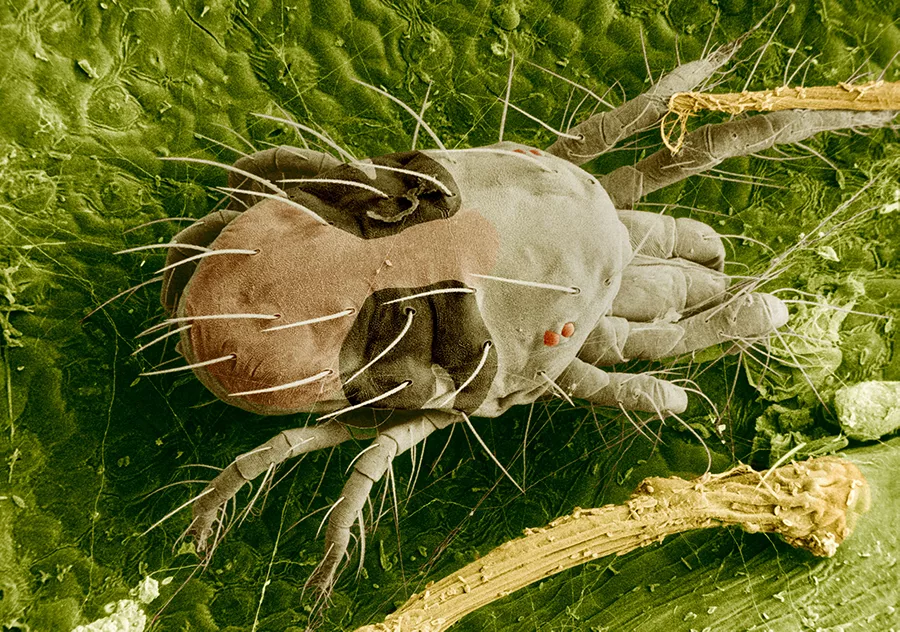
In the right conditions, the eggs of a spider mite can hatch in three days and reach adulthood in about a week. Spider mites live 2-4 weeks, and adult females can lay twenty eggs daily. If you visualize the mathematics of their growth, it is easy to see how quickly they can become a threat to your plants.
The life cycle of a spider mite consists of five stages. In each phase, the mite goes through an eating period and a dormant growth period. This makes ridding your plants of them even more challenging. You may treat your plants with a horticultural oil or specialized spider mite killer and eliminate the active ones. But within a day or two, new mites awaken from their growth stages ready to feed.
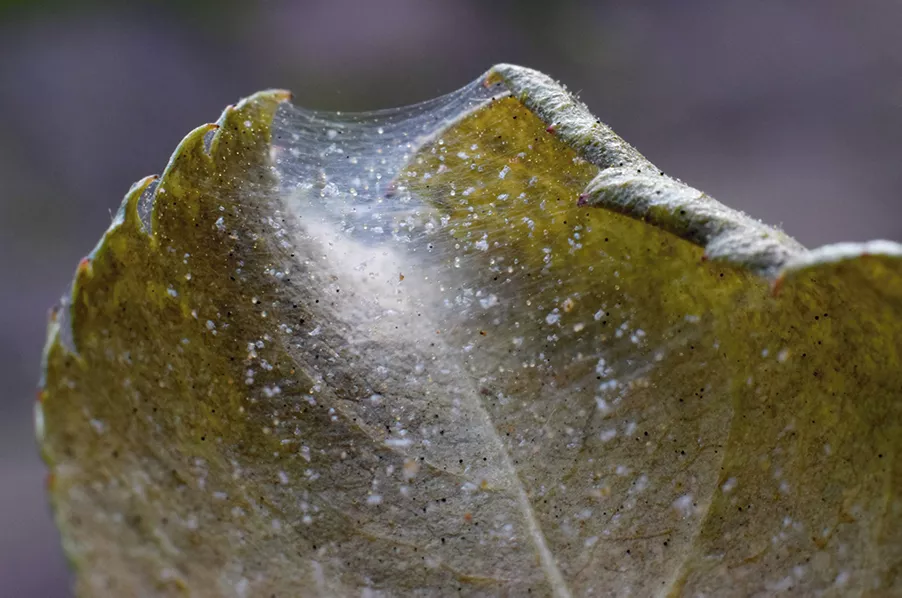
How do they damage my plants?
Spider mites will target the plants with high levels of nitrogen, phosphorus, and carbohydrates. Spider mites feed by piercing the cell walls of the leaf and sucking out the chlorophyll. The plant is left with a series of yellow or white dots, or puckered scars like pin-pricks. This tell-tale pattern of spots is known as stippling. The damage lessens a plant’s ability to maintain moisture and photosynthesize.
A single mite cannot affect the health of your plant. But because of their rapid reproduction, a single female that hitches a ride on the cuff of your pants can produce a thousand hungry mouths in the heart of your garden or grow room. The consequence is failing plants and smaller harvests.
Favored Habitats
Spider mites generally live on the underside of leaves, where they can feed in obscurity. They thrive in hot, dry environments, and drought-stressed plants are their favorite targets. Fortunately, spider mites have many predators, and a healthy outdoor garden is unlikely to suffer greatly.
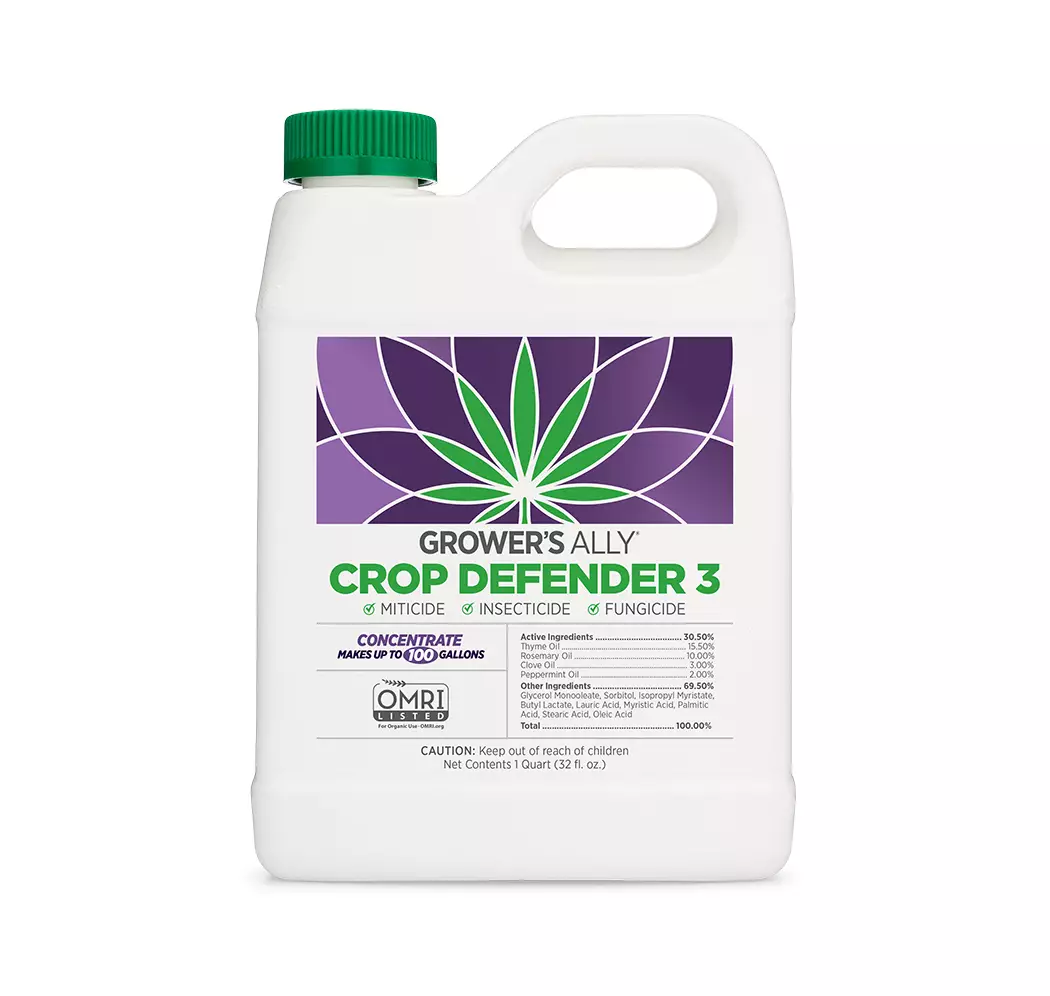
Grower’s Ally Crop Defender 3
Grower’s Ally® Crop Defender 3 is an OMRI Listed® miticide, insecticide and fungicide for weekly use to prevent common pests. Formulated with a synergistic blend of botanical oils and a surfactant, it is a highly effective crop protection formula that can be safely applied up until the day of harvest and leaves zero pollutants. The triple-action formula kills powdery mildew, spider mites, russet mites, thrips, aphids and other soft-bodied insects as well as their eggs on contact. Trusted by large scale growers for use in the flowering stage and suitable for all grow environments and cultivation facilities: indoor, outdoor, greenhouse, hydroponic.
Indoor plants are as likely to be a target as their outdoor counterparts. This may seem surprising until you consider how few spider mite predators live indoors. Any new plant brings with it a chance of carrying spider mites. Store-bought plants are a common source of infestations, as the plants come from several nurseries and are displayed close together.
Spider mites are also a danger to indoor hydroponic systems, especially those that use soil. Even a soil-free garden can be at risk. A single mite hitching a ride on your clothes, or on a new cutting, can lay enough eggs to infest the whole crop in a month. The humidity of a hydroponic environment slows the pests’ egg-laying rate, but it also gives them an advantage: there is no falling water (rain, watering can) to drown them or shake them from the foliage.
Species to Watch For
The two species of spider mites that growers are most likely to encounter are the red spider mite (Tetranychus cinnabarinus) and the two-spotted spider mite (Tetranychus urticae). The red spider mite has been titled “resistance champion among arthropods”, and has been found feeding on over 1,100 plant species world-wide. The two-spotted spider mite attacks over 300 species of plants, encompassing fruits, vegetables, and ornamentals; it also has a reputation for rapidly developing resistance to insecticides.
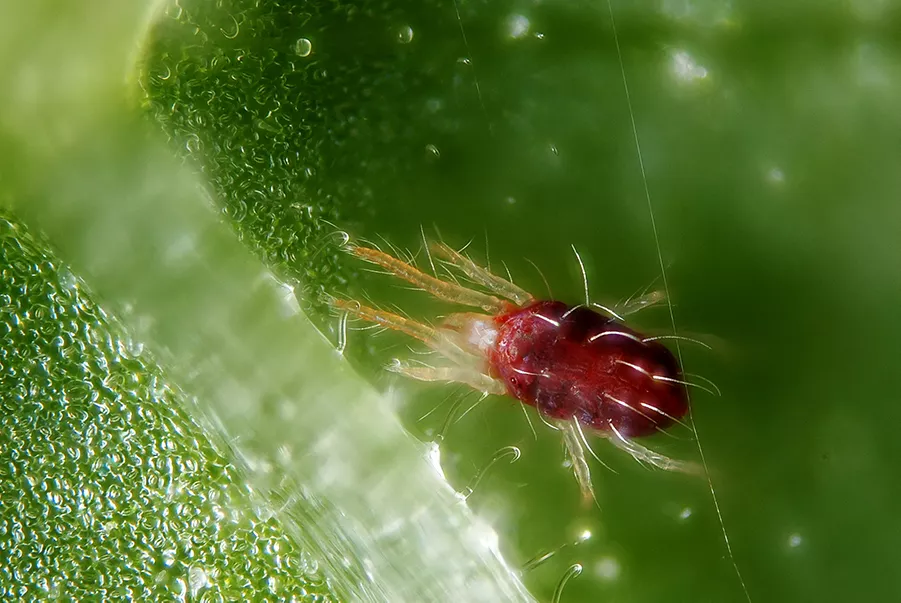
Is it Mites or is it a Nutrient Deficiency?
One reason that spider mites are able to establish themselves in a garden is because the damage they cause can look similar to a nutrient deficiency. By the time a grower takes a close look at a few yellowing leaves, the spider mites have spread to other plants. Before jumping into the complexities of identifying nutrient deficiencies, look for two clear signs of spider mites.
The first method of detecting spider mites requires a piece of white paper and good eyesight (or a magnifying glass). Hold the piece of paper horizontally beneath the ailing leaves. Gently tap and shake the leaves, and then look closely at the paper. If you see tiny, moving specks, your plant has spider mites. If you see signs of damage, but no mites, try again on the leaves above. Spider mites work their way up a plant as they feed.
The second way to detect mites is by looking for their webs. Once spider mites have established themselves, they will begin spinning webs to protect their eggs. Look for fine webbing at the junctions of leaf and stem, or on the underside leaves. You may also be able to see spider mites on the threads of the web. The presence of webs is a sure way to distinguish a spider mite infestation from an infestation of aphids or thrips.
Best Spider Mite Killer
Although there are seemingly countless varieties of spider mites, they fortunately all have the same physiology (soft-bodied, egg-laying, chlorophyll-drinking), so you can use the same approach on any of them. Your choices are traditional insecticides, horticultural oils, or natural extracts.
No matter which route you choose, remember that spider mites are notoriously resistant to insecticides. You need to be thorough and remain vigilant. At any given time, roughly half of these pests will be in a dormant phase therefore less vulnerable to your efforts.
Traditional Insecticide
Outdoor growers might consider applying a broad-spectrum, synthetic insecticide. There is a tempting ‘two birds, one stone’ mentality: you can rid yourself of aphids and other soft-bodied pests along with those pesky spider mites. However, there are two significant drawbacks to using a common insecticide:
First, spider mites have a reputation for quickly adapting to chemical methods. In fact, some common insecticides actually increase their rate of reproduction! Secondly, resorting to insecticides means killing beneficial insects along with the pests. In fact, mite infestations can break out because pesticides have killed the mites’ predators.
Horticultural Oils
Horticultural oil is a term that covers a range of insecticides based on petroleum or vegetable oil. Some include a natural insecticide, such as neem or rosemary. They are applied by spraying until all leaves are coated — especially the underside! They work by coating the mite, thereby suffocating it.
Organic and Non-Toxic Options
Before discussing these options, we need to know how these terms are defined. Organic insecticides are those that are derived from a living or once-living organism. Non-toxic insecticides are those that have undergone testing and been proven harmless. These two categories overlap, so it’s worth reading labels carefully. Organic insecticides may be toxic or non-toxic; non-toxic insecticides may be organic or synthetic.
The Organic Route
In the culinary world, organic is synonymous with healthy. In the farming world, the term is not so clear. Organic pesticides are often safe. Citrus, neem, and rosemary are examples of non-toxic ingredients in organic pesticides. But others, such as pyrethrins can cause health risks to humans and devastate bees.
While making great strides for health- and earth-conscious growers, organic farming has had a few costly errors in its history. Seemingly safe organic compounds turned out to be toxic to mollusks (spinosa), fish and mammals (rotenone), and humans (Chlorpyrifos). Don’t be lulled into a feeling of safety just because you see the word organic. Research unfamiliar ingredients. Know what the words Caution, Warning, Danger mean.
Organic gardening and organic pest control are healthy, ethical, and viable methods of growing. Just be sure you and your pesticide labels are speaking the same language.
Emphasizing Non-toxic
If you are growing for human consumption, the question of whether the ingredients in your insecticide are organic or synthetic should be secondary. More important is the question, how safe is it? Whether you are growing fruits, herbs, or vegetables, you need a non-toxic way to get rid of spider mites.
A naturally derived miticide should be your first line of defense. A variety of botanical extracts have proven effective. Neem oil is a popular choice. It is commonly available, and is therefore a suitable choice for some growers. However, if you are considering neem oil, be forewarned: its odor has been variously described as garlicky, sulphurous, or bitter.
Fortunately, advances in non-toxic insecticides have created better-smelling alternatives. Extracts of citrus and rosemary are among the organic sources most recently showing promise. Lemon juice is a proven miticide, and the EPA has long acknowledged citric acid as an effective and non-toxic ingredient in pesticides. As an added bonus, citric acid is a proven fungicide as well.
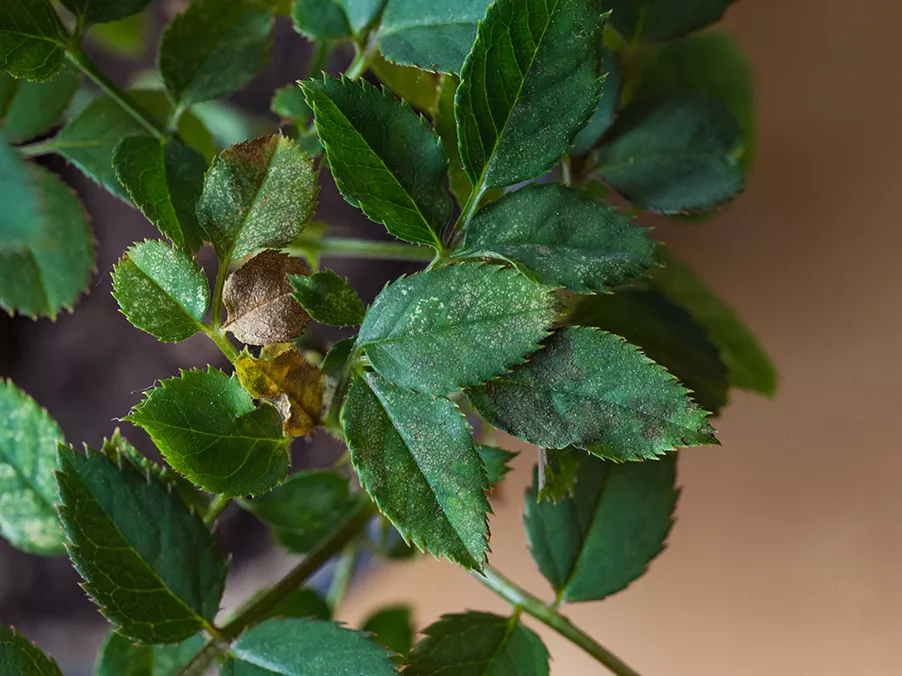
How to Get Rid Of Spider Mites On Plants
Non-toxic pesticides are your best bet for getting rid of spider mites. If your gardening focus is houseplants or ornamentals, you should be armed with enough knowledge to overcome spider mites. But if you are growing flowers, fruits, or vegetables, there are a few more considerations.
There are times in a growing cycle when applying insecticide is impractical, or even harmful to the crop. What if spider mites appear then? You need to know what you can do without hurting your harvest.
How To Get Rid Of Spider Mites During Flowering
Spider mites can strike at any time. When they infest your crops during the flowering, budding, and harvesting stages, added precautions are necessary.
If you are growing a consumable crop, a non-toxic miticide is non-negotiable. And if you are saving seeds for next year’s crop, you need to be mindful. Flowers attract pollinators, who are susceptible to anything you spray.
Bad news: spider mites don’t care if you are two weeks into your grow, or if your plants are in full blossom. If you find tell-tale webs, you have to get rid of them.
Good news: Specialty miticides that are safe to use during flowering exist. Keeping some on hand is like having a fire extinguisher in the kitchen: you rarely need it, but when you do, you need it now!
Spider Mites on Buds At Time of Harvest
Having spider mites appear only a few days before harvest can induce panic. You can’t Introduce any chemicals (synthetic or organic) at this time, lest you contaminate the flavor of your crop. And you certainly can’t present your wares at the farmers market looking like that!
Solutions
Fortunately, you have options when it comes to fighting spider mites while your plants are flowering, budding, or fruiting.
Whisk Them Away
If you have only a few plants, or a few dozen vegetables, you can use a hand-held spray bottle and use aimed squirts to sweep the mites off. You can also remove them by hand with the assistance of a low-powered vacuum.
Introduce Predators
One option is to introduce predatory mites to your garden. Mites and insects that eat spider mites are easy to purchase. Remember, mites work their way up the plant, so if you choose this route to eradicate the pests, release them at the base of the plants and let them work their way up to get them all.
Air Them Out
Another way to fight spider mites is to have fans blowing air through the foliage. This is really a stop-gap measure to contain a small infestation while you work on a more permanent solution. Spider mites like stagnant air, and a constant breeze will help keep them from spreading. As a final resort, you may have to prune infested flowers and leaves to save the rest of the plant.
If you have a large crop, you may have to quarantine the infestation and write off your loss. Discard plants and soil far away from your garden. Wash everything thoroughly. Review your methods, find the weak link, and determine to take the lesson to heart.
Don’t Let it Happen Again
I am sure that once you have dealt with a stubborn infestation of spider mites, you will vow not to let it happen again. Resolve to be mindful of the ways to keep your garden as pest-free as possible. Keep your plants well-watered and healthy. Don’t introduce new plants or cuttings to your growing area. Change the soil, wash your containers, and wipe down your pruning tools between plantings. Keep the natural balance of predators and prey. Make regular spot checks of your plants. And if the spider mites return — now you know what to do.
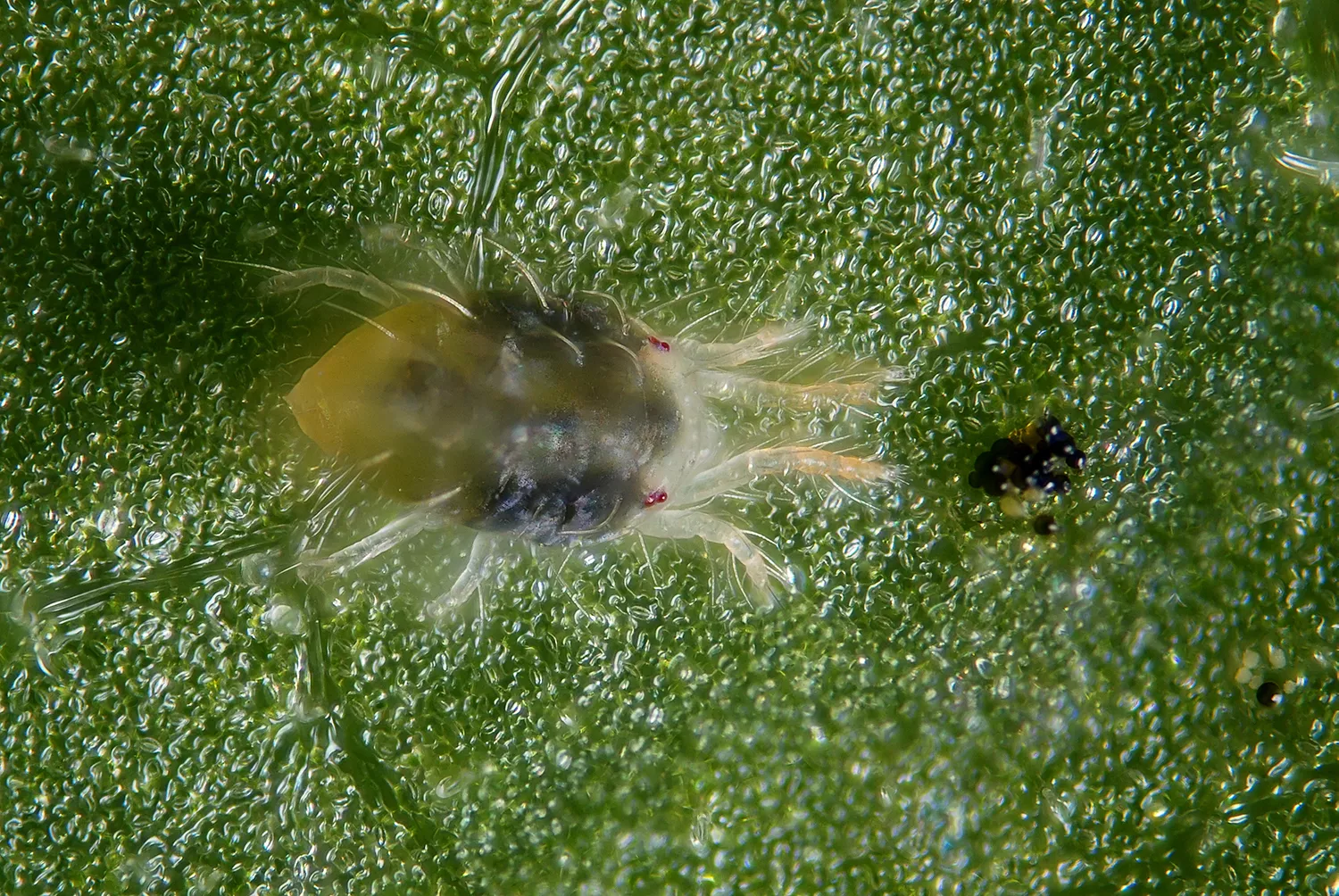
A great write up, on a not at all great sap sucking monster. I’m currently fighting a loosing battle with them now. I recently added beneficial mites, and trying a couple of different sprays, but I fear it was way to late to have done so, as I’ll be removing severely infested plants from my grow today.